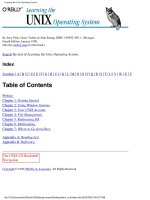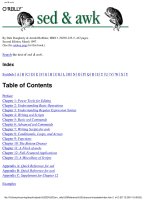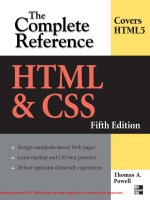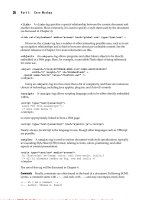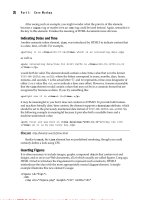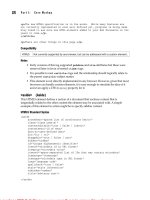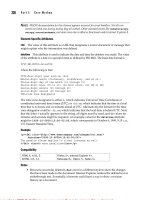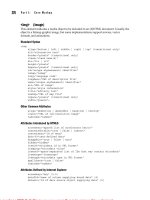o'reilly - dynamic html the definitive reference
Bạn đang xem bản rút gọn của tài liệu. Xem và tải ngay bản đầy đủ của tài liệu tại đây (9.22 MB, 1,088 trang )
Dynamic HTML
The Definitive ReferenceDynamic HTML
The Definitive Reference
Danny Goodman
Beijing
•
Cambridge
•
Farnham
•
Köln
•
Paris
•
Sebastopol
•
Taipei
•
Tokyo
Dynamic HTML: The Definitive Reference
by Danny Goodman
Copyright © 1998 Danny Goodman. All rights reserved.
Printed in the United States of America.
Published by O’Reilly & Associates, Inc., 101 Morris Street, Sebastopol, CA 95472.
Editor:
Paula Ferguson
Production Editor:
Mary Anne Weeks Mayo
Printing History:
July 1998: First Edition.
Nutshell Handbook, the Nutshell Handbook logo, and the O’Reilly logo are registered
trademarks of O’Reilly & Associates, Inc. The association between the image of a flamingo
and the topic of Dynamic HTML is a trademark of O’Reilly & Associates, Inc. Many of the
designations used by manufacturers and sellers to distinguish their products are claimed as
trademarks. Where those designations appear in this book, and O’Reilly & Associates, Inc.,
was aware of a trademark claim, the designations have been printed in caps or initial caps.
While every precaution has been taken in the preparation of this book, the publisher assumes
no responsibility for errors or omissions, or for damages resulting from the use of the
information contained herein.
ISBN: 1-56592-494-0 [1/00]
[M]
v
Dynamic HTML: The Definitive Reference, eMatter Edition
Copyright © 1999 Danny Goodman. All rights reserved.
Table of Contents
Preface ix
I. Applying Dynamic HTML 1
1. The State of the Art 3
The Standards Alphabet Soup 4
Version Headaches 4
HTML 4.0 5
Style Sheets 6
Document Object Model 9
ECMAScript 11
A Fragmenting World 12
2. Cross-Platform Compromises 14
What Is a Platform? 14
Navigator 4 DHTML 15
Internet Explorer 4 DHTML 19
Cross-Platform Strategies 21
Cross-Platform Expectations 27
3. Adding Style Sheets to Documents 28
Rethinking HTML Structures 28
Understanding Block-Level Elements 31
Two Types of Containment 33
CSS Platforms 35
Of Style Sheets, Elements, Attributes, and Values 36
vi Table of Contents
Dynamic HTML: The Definitive Reference, eMatter Edition
Copyright © 1999 Danny Goodman. All rights reserved.
Embedding Style Sheets 39
Subgroup Selectors 44
Attribute Selector Futures: CSS2 51
JavaScript Style Sheet Syntax 54
Cascade Precedence Rules 59
Cross-Platform Style Differences 62
4. Adding Dynamic Positioning to Documents 65
Creating Positionable Elements 66
Positioning Attributes 74
Changing Attribute Values via Scripting 80
Cross-Platform Position Scripting 86
Handling Navigator Window Resizing 93
Common Positioning Tasks 93
5. Making Content Dynamic 102
Writing Variable Content 102
Writing to Other Frames and Windows 104
Links to Multiple Frames 108
Image Swapping 109
Changing Tag Attribute Values 112
Changing Style Attribute Values 113
Changing Content 117
6. Scripting Events 132
Basic Events 132
Binding Event Handlers to Elements 135
Event Handler Return Values 139
Event Propagation 139
Examining Modifier Keys 147
Examining Mouse Buttons and Key Codes 150
Dragging Elements 152
Event Futures 156
7. Looking Ahead to HTML 4.0 157
New Directions Overview 158
New Elements 160
Deprecated Elements 161
Obsolete Elements 161
New Element Attributes 161
Deprecated Attributes 162
Table of Contents vii
Dynamic HTML: The Definitive Reference, eMatter Edition
Copyright © 1999 Danny Goodman. All rights reserved.
II. Dynamic HTML Reference 165
8. HTML Reference 167
Attribute Value Types 168
Common HTML Attributes 171
Alphabetical Tag Reference 174
9. Document Object Reference 460
Property Value Types 461
About client- and offset- Properties 463
Event Handler Properties 464
Common Object Properties, Methods, and Collections 465
Alphabetical Object Reference 475
10. Style Sheet Attribute Reference 836
Attribute Value Types 837
Pseudo-Elements and Pseudo-Classes 839
At-Rules 840
Conventions 841
Alphabetical Attribute Reference 842
11. JavaScript Core Language Reference 909
Internet Explorer JScript Versions 909
About Static Objects 910
Core Objects 911
Operators 956
Control Statements 967
Global Functions 972
Statements 976
III. Cross References 979
12. HTML Attribute Index 981
13. Document Object Properties Index 987
14. Document Object Methods Index 1002
15. Document Object Event Handlers Index 1007
viii Table of Contents
Dynamic HTML: The Definitive Reference, eMatter Edition
Copyright © 1999 Danny Goodman. All rights reserved.
IV. Appendixes 1011
A. Color Names and RGB Values 1013
B. HTML Character Entities 1018
C. Keyboard Event Character Values 1026
D. Internet Explorer Commands 1028
Glossary 1033
Index 1041
ix
Dynamic HTML: The Definitive Reference, eMatter Edition
Copyright © 1999 Danny Goodman. All rights reserved.
Preface
Preface
I am going to admit a selfish motive for writing this book: I needed the finished
product for my own consulting and development work. After struggling with tan-
gled online references and monstrous printed versions of Netscape, Microsoft, and
World Wide Web Consortium (W3C) documentation for Dynamic HTML (DHTML)
features, I had had enough. My human brain could no longer store the parallels
and discrepancies of the hundreds of terms for HTML attributes, style sheets, and
scriptable object models. And no browser maker was about to tell me how com-
patible a particular feature might be in another browser. It was clearly time to roll
my own reference.
At first, I thought the project would be a relatively straightforward blending of con-
tent from available sources, with a pinch of my development experience thrown in
for flavoring. But the more I examined the existing documents, the worse the situ-
ation became. Developer documentation from the browser makers, and even the
W3C, contained inconsistencies and incomplete (if at times erroneous) informa-
tion. From the very beginning, it was clear that I could not trust anything I read,
but instead had to try as much as I could on as many browsers and browser ver-
sions as I could. Multiply all that code testing by the hundreds of HTML attributes,
CSS attributes, object properties, object methods, and event handlers before I
knew it, many extra months of day-and-night coding and writing were history.
The result of that effort is the DHTML reference I’ve been wanting for a long
time—one that is especially well suited to creating content that works on Naviga-
tor and Internet Explorer. But even if you have the luxury of working in only one
of the browser brands, you should find the organization and browser version
information in this book valuable in your day-to-day development work. You may
also encounter descriptions of features that are not documented, but came to light
as a result of my probing into the inner workings of both browsers.
x Preface
Dynamic HTML: The Definitive Reference, eMatter Edition
Copyright © 1999 Danny Goodman. All rights reserved.
I would be the last person on the planet to promise that this book is perfect in
every way. In many instances, when a discrepancy between vendor documenta-
tion and observable reality occurred, I documented the reality. But there were
times during my explorations when even the observed reality didn’t jibe with
either the documentation or logical expectations. In some instances, the docu-
ments say one thing, and the implementations in two different operating system
versions of the same browser exhibit two entirely different behaviors. I have tried
to point out those issues as cautions for your own development, hoping for clarifi-
cation in future versions of the browsers and the W3C documents.
What You Should Already Know
Because this is a reference book, it has been written with the assumption that, in
the least, you have dabbled in Dynamic HTML. You should already be HTML liter-
ate and know the basics of client-side scripting in JavaScript. You need not be a
DHTML expert, but even the instructional chapters of Part I are very much crash
courses, intended for readers who are already comfortable with hand-coding web
pages (or at least modifying the HTML generated by WYSIWYG authoring tools).
Contents of This Book
This book is divided into four parts:
Part I, Applying Dynamic HTML
After making sense of the alphabet soup of industry standards surrounding
DHMTL, the chapters in this part demonstrate the use of cascading style
sheets, element positioning, dynamic content, and scripting events. These
chapters reveal not only how each browser implements the various DHTML
technologies, but also how to deploy as much as possible in a form that works
on both Navigator and Internet Explorer.
Part II, Dynamic HTML Reference
The chapters of Part II provide at-a-glance references for the tags, attributes,
objects, properties, methods, and event handlers of HTML, CSS, DOM, and
core JavaScript. These are the chapters I use all the time: to look up the
attributes of an HTML element or to see whether a particular object property is
available in the desired browser brands and versions. Every effort has been
expended to present this information in a condensed yet meaningful format.
Part III, Cross References
The chapters in Part III slice through the information of Part II along different
angles. Perhaps you recall the name of an attribute you found useful some
time ago, but don’t recall which elements provide that attribute. Here you can
Preface xi
Dynamic HTML: The Definitive Reference, eMatter Edition
Copyright © 1999 Danny Goodman. All rights reserved.
look up that attribute (or object property, method, or event handler) to find all
the items that recognize it.
Part IV, Appendixes
Several appendixes provide quick lookup for a variety of values useful in
HTML authoring and scripting. A glossary also gives you quick explanations of
some of the new and potentially confusing terminology of DHTML.
Conventions Used in This Book
Italic is used for:
• Pathnames, filenames, program names, email addresses, and web sites
• New terms where they are defined
Constant Width is used for:
• Any HTML, CSS, or scripting term, including HTML tags, attribute names,
object names, properties, methods, and event handlers
• All HTML and script code listings
Constant Width Italic is used for:
• Method and function parameter or assigned value placeholders that indicate
an item is to be replaced by a real value in actual use
Throughout Part II, compatibility tables accompany most entries. A number shown
for an item indicates the version of the designated browser or web standard in
which the term was first introduced. If an item premiere predates Navigator 2,
Internet Explorer 3, or HTML 3.2, it is assigned the value “all”. If an item is not
supported by a browser or standard as the book went to press, it is assigned the
value “n/a”.
Request for Comments
Your feedback on the quality of this book is important to us. If you discover any
errors, bugs, typos, explanations that you cannot grok, or platform-specific issues
not covered here, please let us know. You can email your bug reports and com-
ments to us at:
Also be sure to check the errata list at />Previously reported errors and corrections are available for public view and fur-
ther comment.
xii Preface
Dynamic HTML: The Definitive Reference, eMatter Edition
Copyright © 1999 Danny Goodman. All rights reserved.
Acknowledgments
I had long wanted to write a book for the “class act” that is O’Reilly & Associates. I
thank Tim O’Reilly for trusting that my personal need for this book would trans-
late into the needs of other web page authors. Then I had the good fortune of the
book being assigned to Paula Ferguson, a first-rate editor in her own right (you
probably have on your bookshelf one or more excellent O’Reilly titles that have
benefited from her guidance). The reference chapters of this book presented
extraordinary design challenges that would make most publishers wince. Paula
shared my vision and worked magic with the O’Reilly designers to turn my dream
into a reality.
When I write about a comparatively new technology—and a complex one at
that—it is difficult to find someone who is knowledgeable enough to double-
check my work and articulate how to make things better. Amid the politically
charged browser wars, it is even more difficult to find a bipartisan supporter of the
developer in the trenches. I couldn’t have been luckier than when my old friend,
Dan Shafer, recommended his BUILDER.COM colleague, Charity Kahn, for the job.
I doubt she expected to wrestle with the nearly one-foot-thick original manu-
script, but she stuck with it to the very end. I still marvel at the insight and experi-
ence embedded within each comment and suggestion she made.
This book would not exist were it not for the many readers of my articles and
books over the past 20 years. My greatest reward has been to help you unlock
your own talent and create great solutions. To new readers, I bid you welcome, as
we all explore the possibilities that lie ahead in this new era of Dynamic HTML.
Dynamic HTML: The Definitive Reference, eMatter Edition
Copyright © 1999 Danny Goodman. All rights reserved.
I
I. Applying Dynamic HTML
This part of the book, Chapters 1 through 7, tries to make sense of the alphabet
soup of industry standards surrounding DHTML and demonstrates the use of cas-
cading style sheets, element positioning, dynamic content, and scripting events.
These chapters explain how Netscape Navigator and Microsoft Internet Explorer
implement the various DHTML technologies, and they discuss how to develop
cross-browser web applications.
• Chapter 1, The State of the Art
• Chapter 2, Cross-Platform Compromises
• Chapter 3, Adding Style Sheets to Documents
• Chapter 4, Adding Dynamic Positioning to Documents
• Chapter 5, Making Content Dynamic
• Chapter 6, Scripting Events
• Chapter 7, Looking Ahead to HTML 4.0
Applying
Dynamic HTML
Dynamic HTML: The Definitive Reference, eMatter Edition
Copyright © 1999 Danny Goodman. All rights reserved.
Chapter 1Applying Dynamic HTML
In this chapter:
• The Standards
Alphabet Soup
• Version Headaches
• HTML 4.0
• Style Sheets
• Document Object
Model
• ECMAScript
• A Fragmenting World
1
1. The State of the Art
It wasn’t all that long ago that becoming a web page authoring wizard required lit-
tle more than an understanding of a few dozen Hypertext Markup Language
(HTML) tags, and perhaps modest experience with a scanner and a graphics pro-
gram to generate a corporate logo image file. Armed with that knowledge, you
could start an Internet design business or become the online content guru at a For-
tune 500 company. Ah, those were the good old days about two years ago.
The stakes are much higher now. The hobby phase is over. The Internet is big
business. Competition for visitor “hits” is enormous, as it becomes more and more
difficult to get your site noticed, much less bookmarked. Sensing that the author-
ing world wanted more out of HTML than a poor imitation of the printed page, the
web browser makers and the Internet standards bodies have been expanding the
capabilities of web pages at a feverish pace. These changes are allowing us to
make our pages more dynamic—pages that can “think and do” on their own,
without much help from the server once they have been loaded in the browser.
But at the same time, what we authors have to do to make our new, fancy con-
tent play on all the browsers is constantly changing.
As a result, it is no longer possible to become a web content guru by studying the
formal HTML recommendation published by the World Wide Web Consortium
(W3C). Adding effective Dynamic HTML (DHTML) content to your pages requires
an understanding of other technologies, specified by additional standards that exist
outside the charter of the original HTML Working Group. In this chapter, we’ll dis-
cuss the variety of standardization efforts that are currently underway. You should
begin to appreciate both how far the browser makers have come and how far they
have to go in providing us with compatible DHTML capabilities at a suitably high
level.
4 Chapter 1: The State of the Art
Dynamic HTML: The Definitive Reference, eMatter Edition
Copyright © 1999 Danny Goodman. All rights reserved.
The Standards Alphabet Soup
There is no such thing as a single Dynamic HTML standard. DHTML is an amal-
gam of specifications that stem from multiple standards efforts and proprietary
technologies that are built into the two most popular DHTML-capable browsers,
Netscape Navigator and Internet Explorer, beginning with Version 4 of each
browser.
Efforts by various standards bodies and working groups within those bodies are as
fluid and fast moving as any Internet-related technology. As a savvy web content
author these days, you must know the acronyms of all relevant standards (HTML,
CSS, CSS-P, DOM, and ECMA for starters). You also have to keep track of the cur-
rent release of each standard, in addition to the release that is incorporated into
each version of each browser that you are developing for. Unfortunately for the
authoring community, it is not practical for the various standards bodies and the
browser makers to operate in complete synchronicity with each other. Market
pressures force browser makers to release new versions independent of the sched-
ules of the standards bodies.
Version Headaches
As a further complication, there are the inevitable prerelease versions of browsers
and standards.
Browser prereleases are sometimes called “preview editions” or “beta” versions.
While not officially released, these versions give us a chance to see what new
functionality will be available for content display in the next-generation browser.
Authors who follow browser releases closely sometimes worry when certain
aspects of their current pages fail to work properly in prerelease versions. The fear
is that the new version of the browser is going to break a carefully crafted master-
piece that runs flawlessly in released versions of the browser.
Somewhere between the releases of Netscape Navigator 2 and 3, I learned not to
fret over breakages that occur in prerelease browser versions. Of course, it is vital
to report any problems to the browser maker. I refuse, however, to modify my
HTML or scripting code to accommodate a temporary bug in a prerelease version
of a browser, as it is being used by an extremely small percentage of the popula-
tion. My feeling is that anyone who uses a prerelease browser does so at his or
her own risk. If my pages are breaking on that browser, they’re probably not the
only ones on the Net that are breaking. A user of a prerelease browser must
understand that using such a browser for mission-critical web work is as danger-
ous as entrusting your life’s work to a beta version of a word processing program.
Applying
Dynamic HTML
HTML 4.0 5
Dynamic HTML: The Definitive Reference, eMatter Edition
Copyright © 1999 Danny Goodman. All rights reserved.
On the standards side, working groups usually publish prerelease versions of their
standards. These documents are very important to the people who build browsers
and authoring tools for us. The intent of publishing a working draft is not much
different from making a prerelease browser version public. The goal is to get as
many concerned netizens as possible looking over the material to find flaws or
shortcomings before the standard is published.
And speaking of standards, it is important to recognize that the final releases of
these documents from standards bodies are called not “standards” but “recommen-
dations.” No one is forcing browser makers to implement the recommendations.
Fortunately, from a marketing angle, it plays well to the web audience that a com-
pany’s browser adheres to the “standards.” Eventually—after enough release cycles
of both standards and browsers allow everyone to catch up with each other—our
lives as content creators should become easier.
In the meantime, the following sections provide a snapshot of the various stan-
dards and their implementation in browsers as they relate to the technologies that
affect DHTML.
HTML 4.0
The most recent release of recommendations for HTML is Version 4.0
(www.w3.org/MarkUp/). As you will see in more detail in Chapter 7, Looking
Ahead to HTML 4.0, HTML 4.0 has a considerably larger vocabulary than the previ-
ous release that is in common use, Version 3.2. Surprisingly, this time around the
standard is way ahead of the browser makers. Many of the new features of HTML
4.0 are designed for browsers that make the graphical user interface of a web page
more accessible to users who cannot see a monitor or use a keyboard. The new
tags and attributes readily acknowledge that a key component of the name World
Wide Web is World. Users of all different written and spoken languages need
equal access to the content of the Web. Thus, HTML 4.0 includes support for the
alphabets of most languages and provides the ability to specify that a page be ren-
dered from right to left, rather than left to right, to accommodate languages that
are written that way.
Perhaps the most important long-term effect of HTML 4.0, however, is distancing
the content of web pages from their formatting. Strictly speaking, the purpose of
HTML is to provide structural meaning to the content of pages. That’s what each
tag does: this blurb of text is a paragraph, another segment is labeled internally as
an acronym, and a block over there is reserved for data loaded in from an exter-
nal multimedia file. HTML 4.0 is attempting to wean authors from the familiar tags
that make text bold and red, for example. That kind of information is formatting
information, and it belongs to a separate standardization effort related to content
style.
6 Chapter 1: The State of the Art
Dynamic HTML: The Definitive Reference, eMatter Edition
Copyright © 1999 Danny Goodman. All rights reserved.
In the HTML 4.0 world, a chunk of text in a paragraph is bold because it is tagged
as being an element that requires emphasis. Whether it is bold or italic or green is
not defined by the HTML vocabulary, per se. Instead, the HTML passes the format-
ting decision to a style definition. When the text is viewed in a browser on a video
monitor, the color may be green and the style italic, but when the same page is
viewed through a projection system, it may be a different shade of green, to com-
pensate for the different ambient lighting conditions, and bold, so it is more read-
able at a distance. And when the content is being read aloud electronically for a
blind user, the voice speaks the tagged words with more emphasis. The key point
here is that the content—the words in this case—was written and tagged once.
Style definitions, either in the same document or maintained in separate files that
are linked into the document, can be modified and enhanced independently of the
content.
As a modern HTML author, you should find it encouraging that the HTML 4.0
working group did not operate in isolation from what is going on in the real
world. Their recognition of the work going on with style sheets is just one exam-
ple. Another is their clear understanding of the role of client-side scripting: the
<SCRIPT> and <NOSCRIPT> tags are part of the HTML 4.0 specification, and most
elements that get rendered on the page have scripting event handler attributes
defined for them right in the HTML 4.0 specification. This represents a very realis-
tic view of the web authoring world.
Netscape Navigator 4 was released many months before the HTML 4.0 specifica-
tion was published, which means that the HTML support in that browser was
decided on well before the scope of HTML 4.0 was finalized. As a result, Naviga-
tor’s support for the new features of HTML 4.0 is limited to the internationaliza-
tion features and the separation of style from content by way of style sheets. Many
of the new tags and the new attributes for existing tags are not supported in Navi-
gator 4. Internet Explorer 4 reached its final release much closer to the publica-
tion of the HTML 4.0 specification; as a result, the Microsoft browser includes sub-
stantially more support for new features of HTML 4.0, especially in the way of
structural elements for table components. Chapter 7 describes which new tags are
supported by each browser, and Chapter 8, HTML Reference, provides a complete
HTML reference.
Style Sheets
A style sheet is a definition of how content should be rendered on the page. The
link between a style sheet and the content it influences is either the tag name of
the HTML element that holds the content or an identifier associated with the ele-
ment by way of an attribute (such as the ID or CLASS attribute). When a style
sheet defines a border, the style definition doesn’t know (or care) whether the
Applying
Dynamic HTML
Style Sheets 7
Dynamic HTML: The Definitive Reference, eMatter Edition
Copyright © 1999 Danny Goodman. All rights reserved.
border will be wrapped around a paragraph of text, an image, or an arbitrary
group of elements. All the style knows is that it specifies a border of a particular
thickness, color, and type for whatever element or identifier is associated with the
style. That’s how the separation of style from content works: the content is igno-
rant of the style and the style is ignorant of the content.
The standardization efforts for style sheets are still trying to establish themselves,
despite the fact that some versions have already been published. At the time the
Version 4 implementations of Navigator and Internet Explorer were under con-
struction, there were two separate, but related, style sheet efforts underway: Cas-
cading Style Sheets Level 1 (CSS1) and Cascading Style Sheets-Positioning (CSS-P).
The CSS-P functionality is being blended into the primary specification for the next
version of CSS, Cascading Style Sheets Level 2 (CSS2). All CSS standards activity is
under the auspices of the W3C (www.w3c.org/Style/ ). Chapter 10, Style Sheet
Attribute Reference, provides a complete reference for all the style attributes avail-
able in CSS1 and CSS2.
CSS1
The Cascading Style Sheets Level 1 recommendation lets authors define style rules
that are applied to HTML elements. A rule may apply to a single element, a related
group of elements, or all elements of a particular type (such as all P elements).
Style rules influence the rendering of elements, including their color, alignment,
border, margins, and padding between borders and the content. Style rules can
also control specialty items, such as whether an OL element uses letters or roman
numerals as item markers. CSS1 defines a full syntax for assigning style attributes
to rules.
CSS frees you from the tyranny of the pixel and the arbitrary way that each
browser measures fonts and other values. Font sizes can be specified in real point
sizes, instead of the absurd 1-through-7 relative scale of HTML. If you want a para-
graph or a picture indented from the left margin, you can do so with the preci-
sion of ems or picas, instead of relying on hokey arrangements of tables and trans-
parent images.
Many of the style specifications that go into CSS rules derive their inspiration from
existing HTML tag attributes that control visual aspects of elements. In some cases,
style sheet rules even supplant entire HTML elements. For example, in the world
of CSS, font changes within a paragraph are not done with <FONT> tags. Instead, a
style sheet rule sets the font, and the style rule is assigned to structural HTML ele-
ments (perhaps <SPAN> tags) that surround the affected content.
On their own, style sheets as described in the CSS1 specification are not dynamic.
They simply set rules that are followed as a page loads. But under script control,
8 Chapter 1: The State of the Art
Dynamic HTML: The Definitive Reference, eMatter Edition
Copyright © 1999 Danny Goodman. All rights reserved.
there is the possibility of changing a style rule after a page has loaded. Of course,
the browser must be constructed to allow such on-the-fly changes. I’ll have more
to say about that in the section on the document object model.
Netscape Navigator 4 implements most of the CSS1 specification. In addition to the
standard CSS1 rule specification syntax, Navigator offers authors an alternate syn-
tax (based on JavaScript) to assign style sheet rules to elements. We’ll talk more
about this alternate syntax in Chapter 3; for now it is important to understand that
it is merely another way of specifying CSS1 functionality. Internet Explorer began
supporting CSS1 in Version 3, although the functionality was little used by authors
unless the target audience was using IE 3 exclusively. More complete support of
the CSS1 specification is built into Version 4, but even in this version Microsoft has
elected to omit a few features. The good news is that CSS1 functionality is largely
the same in both IE 4 and Navigator 4, so we should start to see increased usage
of style sheets on the Web.
CSS-P
Begun as a separate working group effort, Cascading Style Sheets-Positioning
offers much more in the way of interactivity: more of the D in DHTML. The basic
notion of CSS-P is that an element or group of elements can be placed in its own
plane above the main document. The element lives in its own transparent layer, so
it can be hidden, shown, precisely positioned, and moved around the page with-
out disturbing the other content or the layout of the document. For the first time,
HTML elements can even overlap each other.
A script can make elements fly around the page or it can allow the user to drag
elements around the page. Content can pop up out of nowhere or expand to let
the viewer see more content—all without reloading the page or contacting the
server.
As an add-on to the CSS1 effort, CSS-P functionality uses a syntax that simply
extends the CSS1 vocabulary. CSS-P rules are embedded in documents the same
way that CSS1 rules are embedded.
The W3C work on CSS-P wasn’t as far along as CSS1 was when Navigator 4 had to
be put to bed. Moreover, Netscape had been lobbying the standards bodies to
adopt a different technique for handling content positioning, involving both a new
HTML tag and a scriptable object. Navigator 4 therefore implements the <LAYER>
tag and a scriptable layer object. A Netscape layer is in most respects the same as
a CSS-P layer, except that Netscape wanted to make it a part of the HTML syntax
as well.
Unfortunately for Netscape and Navigator 4, the <LAYER> tag was not adopted by
the W3C for HTML 4.0, and it is not likely that it will be added in the future. Even
Applying
Dynamic HTML
Document Object Model 9
Dynamic HTML: The Definitive Reference, eMatter Edition
Copyright © 1999 Danny Goodman. All rights reserved.
so, if you are authoring for a Navigator-only audience, the LAYER element is a
convenient way to work with positionable elements. While its existence may not
be emphasized by Netscape in future browsers, it will certainly be available for
backward compatibility with pages that use it.
The good news for authors, however, is that whether you create a positionable
element via the CSS-P syntax or as a LAYER element, scripting the element on the
fly is the same in Navigator. The Netscape layer object exposes most of the CSS-P
properties for access via scripts.
In contrast, Internet Explorer 4 follows the CSS-P specification very closely. Includ-
ing a single attribute (the position attribute) in a style sheet rule makes the ele-
ment associated with that rule positionable.
The bad news for authors is that Microsoft’s way of working with positionable ele-
ments in scripts is different from Netscape’s way. All is not lost, however.
Chapter 4, Adding Dynamic Positioning to Documents, demonstrates ways to raise
the common denominator of positionable element scripting for both browsers in
the same document.
CSS2
In the next generation, Cascading Style Sheets Level 2, the work from the CSS-P
group is being blended with the other style sheet specifications. Therefore, with
the release of CSS2, there is no separate CSS-P specification. CSS2 also greatly
expands on CSS1 by supporting style sheet functionality for a lot of the advanced
work in HTML 4.0. Thus, you’ll find new style sheet attributes for electronic
speech (aural style sheets) and more attributes designed to remove style burdens
from HTML element attributes.
CSS2 is more recent than either Version 4 browser. Navigator 4 incorporates noth-
ing yet from CSS2, and Internet Explorer 4 has only a smattering of CSS2 attributes
built in. A lot of the new items added to CSS2 are optional, so there is no reason
to expect a 100% implementation in any browser in the future.
Document Object Model
When an HTML page loads into a scriptable browser, the browser creates a hid-
den, internal roadmap of all the elements it recognizes as scriptable objects. This
roadmap is hierarchical in nature, with the most “global” object—the browser win-
dow or frame—containing a document, which, in turn, contains a form, which, in
turn, contains form elements. For a script to communicate with one of these
objects, it must know the path through the hierarchy to reach the object, so it can
call one of its methods or set one of its property values. Document objects are the
“things” that scripts work with.
10 Chapter 1: The State of the Art
Dynamic HTML: The Definitive Reference, eMatter Edition
Copyright © 1999 Danny Goodman. All rights reserved.
Without question, the most hotly contested competition between Navigator and
Internet Explorer has been how each browser builds its internal roadmap of
objects. This roadmap is called a document object model (DOM). When one
browser implements an object as scriptable but the other doesn’t, it drives script-
ers and page authors to distraction. A lot of authors felt the sting of this problem
when they implemented image-swapping mouse rollovers in Navigator 3. They
soon discovered that images were not scriptable objects in Internet Explorer 3, so
their IE 3 users were getting script errors when visiting the sites and moving their
mice across the hot images.
In an effort to standardize this area, a separate working group of the W3C is
charged with setting recommendations for an HTML Document Object Model
(www.w3c.org/DOM/) that would become the common denominator among
browsers (the HTML subgroup is only one branch of a larger DOM effort). This is
an incredibly difficult task for a number of reasons: Netscape and Microsoft are
often at loggerheads on DOM philosophy; technically the browsers aren’t built the
same way inside, making common implementation of some ideas difficult; and his-
torically authors are familiar with their favorite browser’s way of handling objects
and don’t want to learn an entirely new method.
Of all the standards discussed in this chapter, DOM is the least solid. From indica-
tions in the working drafts, even the first release won’t cover some important cate-
gories, such as event handling. The issues around incompatible DOMs involve a
long, uphill struggle that DHTML authors will face for a while. We will be tanta-
lized by features of one browser, only to have our hopes dashed when we learn
that those features aren’t available in the other browser.
By virtue of being the first scriptable browser on the market by quite a margin,
Navigator 2 was the first to incorporate a scriptable object model. A subset of
HTML elements were exposed to scripts, but once a document was loaded into a
window or frame, nothing outside of form control content (i.e., text in text entry
areas, selections in checkboxes, etc.) could really change without reloading the
window or dynamically writing an entirely new document to the window. Even in
Navigator 3, the image was the only truly dynamic HTML element in a document
(as shown in those mouse rollovers).
Internet Explorer 3, as few web authors seemed to realize, was based on the
scriptability of Navigator 2. That’s why the image object didn’t exist in IE 3. Most
authors had left Navigator 2 in the dust of history, when, in fact, they should have
kept its limited capabilities fresher in their minds, to accommodate IE 3.
In the Version 4 browsers, however, the object model advantage has shifted dra-
matically in Microsoft’s favor. Literally every HTML element is exposed as a script-
able object in IE 4, and you can modify the content and style of inline content (not
Applying
Dynamic HTML
ECMAScript 11
Dynamic HTML: The Definitive Reference, eMatter Edition
Copyright © 1999 Danny Goodman. All rights reserved.
just positionable elements) on the fly. IE 4 automatically reflows the page (and
quickly, I might add) whenever you do anything that changes the page, like
adjusting the size of a font for a phrase in a paragraph or inserting some HTML
text in the middle of a paragraph.
Navigator 4, on the other hand, adds little to dynamic scripting beyond the ability
to swap the content of layers. Elements are exposed to scripts, but only in script
statements that use JavaScript to set style sheet rules as the page loads. And even if
the object model allowed content modification on the fly, pages do not automati-
cally reflow in Navigator 4.
The working draft of the DOM recommendation includes specifications that are
somewhere between the functionality provided by IE 4 and that provided by Navi-
gator 4. The draft recognizes that most elements should be reflected as document
objects whose properties and methods are accessible via scripting. It does not,
however, go so far as to dictate the automatic reflow of the page when content
changes. That loophole might take some of the pressure off Netscape for imple-
menting this functionality, but it also ensures that page authors are going to have
to struggle with the object model disparity for a lot longer (unless you are fortu-
nate enough to be able to design for just one browser).
Chapter 5, Making Content Dynamic, and Chapter 6, Scripting Events, cover the
current DOM implementations, while Chapter 9, Document Object Reference, pro-
vides a complete DOM reference.
ECMAScript
When Navigator 2 made its debut, it provided built-in client-side scripting with
JavaScript. Despite what its name might imply, the language was developed at
Netscape, originally under the name LiveScript. It was a marketing alliance
between Netscape and Sun Microsystems that put the “Java” into the JavaScript
name. Yes, there are some striking similarities between the syntax of JavaScript
and Java, but those existed even before the name was changed.
Internet Explorer 3 introduced client-side scripting for that browser. Microsoft pro-
vided language interpreters for two languages: VBScript, with its syntax based on
Microsoft’s Visual Basic language, and JScript, which, from a compatibility point of
view, was virtually 100% compatible with JavaScript in Navigator 2.
It is important to distinguish a programming language, such as JavaScript, from the
document object model that it scripts. It is too easy to forget that document objects
are not part of the JavaScript language, but are rather the “things” that program-
mers script with JavaScript (or VBScript). The JavaScript language is actually more
mundane in its scope. It provides the nuts and bolts that are needed for any pro-
12 Chapter 1: The State of the Art
Dynamic HTML: The Definitive Reference, eMatter Edition
Copyright © 1999 Danny Goodman. All rights reserved.
gramming language: data types, variables, control structures, and so on. This is the
core JavaScript language.
From the beginning, JavaScript was designed as a kind of core language that could
be applied to any object model, and this has proven useful. Adobe Systems, for
example, uses JavaScript as the core scripting language for Acrobat Forms script-
ing. The same core language you use in HTML documents is applied to a com-
pletely different object model in Acrobat Forms.
To head off potentially disastrous incompatibilities between the implementations
of core JavaScript in different browsers, several concerned parties (including
Netscape and Microsoft) worked with a European computer standards group now
known only by its acronym: ECMA. The first published standard, ECMA-262
(www.ecma.ch/stand/ecma-262.htm), also known as the politically neutral ECMA-
Script, is essentially the version of JavaScript found in Navigator 3. Both Navigator
4 and Internet Explorer 4 implement this ECMA standard (with only very esoteric
exceptions). In addition, the Version 4 browsers both extend the work of the first
ECMA release in a consonant fashion. The core JavaScript language in Navigator 4
(JavaScript 1.2) is supported almost to the letter by JScript in Internet Explorer 4.
After the dissonance in the object model arena, it is comforting for web authors to
see so much harmony in the core language implementation. For the objects in the
core JavaScript language, Chapter 11, JavaScript Core Language Reference, pro-
vides a complete reference.
A Fragmenting World
As you will see throughout this book, implementing Dynamic HTML applications
that work equally well in both Navigator 4 and Internet Explorer 4 can be a chal-
lenge unto itself. Understanding and using the common-denominator functionality
among the various pieces of DHTML will lead you to greater success than plow-
ing ahead with a design for one browser and crossing your fingers about how
things will work in the other browser.
One more potential gotcha is that the same browser brand and version may not
behave identically across different operating systems. Navigator 4 is pretty good
about maintaining compatibility when you open a document in operating systems
as diverse as Solaris and Windows 3.1. The same can’t be said for Internet
Explorer 4, however. Microsoft readily admits that some features (detailed in later
chapters) are guaranteed to work only on Win32 operating systems (Windows 95,
Windows 98, and Windows NT 4). Even features that should work on non-Win32
systems, such as style sheets, don’t always translate well to, say, the Macintosh ver-
sion of IE 4.
Applying
Dynamic HTML
A Fragmenting World 13
Dynamic HTML: The Definitive Reference, eMatter Edition
Copyright © 1999 Danny Goodman. All rights reserved.
If the inexorable flow of new browser versions, standards, and authoring features
teaches us anything, it is that each new generation only serves to fragment further
the installed base of browsers in use throughout the world. While I’m sure that
every reader of this book has the latest sub-version of at least one browser
installed (and probably a prerelease edition of a new version), the imperative to
upgrade rarely trickles down to all the users of yesterday’s browsers. If you are
designing web applications for public consumption, coming up with a strategy for
handling the ever-growing variety of browser versions should be a top priority. It’s
one thing to build a DHTML-based, context-sensitive pop-up menu system into
your pages for IE 4 users. But what happens to users who visit with Navigator 4,
or IE 3, or a pocket computer mini-browser, or Lynx?
There is no quick and easy answer to this question. So much depends on your
content, the image you want to project via your application, and your intended
audience. If you set your sights too high, you may leave many visitors behind; if
you set them too low, your competition may win over visitors with engaging con-
tent and interactivity.
It should be clear from the sheer size of the reference section in this book that
those good ol’ days of flourishing with only a few dozen HTML tags in your head
are gone forever. As much as I’d like to tell you that you can master DHTML with
one hand tied behind your back, I would only be deceiving you. Using Dynamic
HTML effectively is a multidisciplinary endeavor. Perhaps it’s for the best that con-
tent, formatting, and scripting have become separate enough to allow specialists in
each area to contribute to a major project. I’ve been the scripter on many such
projects, while other people handled the content and design. This is a model that
works, and it is likely that it will become more prevalent, especially as each new
browser version and standards release fattens the following pages in the years to
come.
